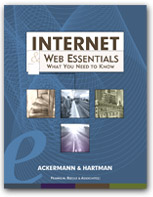Email discussion groups are examples of asynchronous group communication
on the Internet. Group members communicate via email, with messages broadcast
to all group members.
Several thousand discussion groups are available and active on the Internet.
The email groups may be called mailing lists, discussion groups, Listserv
lists, or interest groups. Regardless of the name, each consists of a group
of members on the Internet. This way, communities or collections of people
can discuss items related to a common topic, find information about the topic,
make announcements to the group, and ask questions and receive help from other
group members. The large number of groups or lists guarantees a wide range
of topics. The groups are particularly useful to people who want to discuss
issues with a large or diverse group. The groups extend any resources beyond
a local site.
When you communicate with an email discussion group you send messages
to the list by using the list address. Commands and requests for service are
usually sent to the administrative address. For example, the group SF-LIT,
which deals with a variety of topics related to science fiction literature,
has SF-LIT@loc.gov as the list address and listserv@loc.gov
as the administrative address. You use this second address to join the group,
leave or unsubscribe from the group, request archived files from the group,
and get a list of the members of the group. Be sure you use the correct address
when you communicate with the group or list. Most lists also have a person
designated as the list owner, list administrator, or moderator. That person
is in charge of the list, and you send him or her email if you have problems
using the list or questions about the operation of the list. Some lists are
moderated. Messages sent to the list first go to the moderator, who decides
whether to pass the messages on to all group members.
Several "lists of lists" and other documents related to using
discussion groups are available as part of the World Wide Web. There are also
services on the Web to find discussion groups and to search or retrieve groups’
archives.
The email discussion groups can be thought of as communities of people
sharing common interests. There are generally accepted rules of behavior or
etiquette for list members. These include providing appropriate, thoughtful,
and concise messages to a group, providing a summary of the responses received
in answer to a question, and communicating with other group members in a civil
and respectful manner.
Summary | Terms
| Exercises | FYIs

